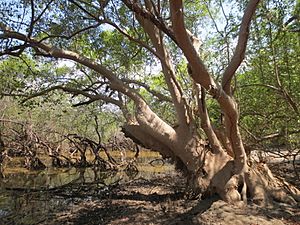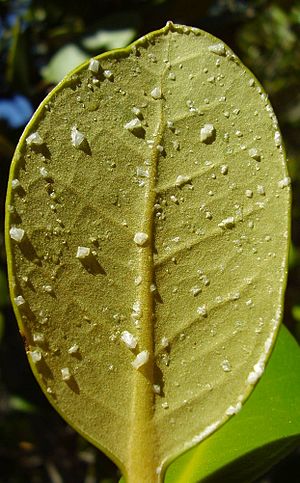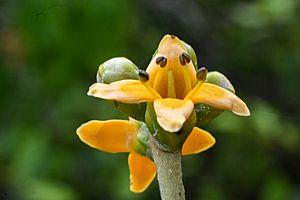Grey mangrove facts for kids
Quick facts for kids Grey mangrove |
|
|---|---|
 |
|
| Avicennia marina at Lake Lago Malai, East Timor | |
| Conservation status | |
| Scientific classification | |
| Genus: |
Avicennia
|
| Species: |
marina
|
| Synonyms | |
|
|
Avicennia marina, often called the grey mangrove or white mangrove, is a unique tree. It belongs to the plant family Acanthaceae. Like other mangrove trees, it lives in the "intertidal zone." This is the area along coastlines that is covered by water at high tide and exposed at low tide.
Contents
Where Do Grey Mangroves Grow?
Grey mangroves are found in many parts of the world. You can see them along the east coast of Africa. They also grow in south-west Asia, and across south and south-east Asia. You'll find them in Australia too.
Grey Mangroves in Different Countries
In New Zealand, these mangroves grow between 34 and 38 degrees south. Their Māori name is mānawa. They are one of the few mangroves that can survive in the dry coastal areas of the Arabian Peninsula. This includes places like the United Arab Emirates, Qatar, and Oman. They also grow along the Red Sea in Yemen, Saudi Arabia, Egypt, Eritrea, and Sudan. You can also find them in southern Iran along the Persian Gulf.
These mangroves are a key part of the Southern Africa mangroves region. They are one of only three mangrove types found in the very south of Africa. This is in the Nahoon River estuary in South Africa. They are also found in Somalia.
Grey Mangroves in Australia
In Australia, grey mangroves grow much further south than other types of mangroves. They are found in almost every mainland state.
Their growth in Western Australia is a bit spread out. For example, a group of them on the Abrolhos Islands is about 300 kilometers (186 miles) south of the next closest group. Another mangrove system is even further south, about 500 kilometers (310 miles) away in Bunbury. Scientists think these southern groups might have arrived relatively recently. Ocean currents, like the Leeuwin Current, might have carried their seeds there thousands of years ago.
The grey mangrove can even grow far from the coast. In Mandora Marsh, some grey mangroves are found about 60 kilometers (37 miles) inland. In South Australia, along the Barker Inlet and Port River, these mangrove forests are very important. They act as nurseries for many fish and shellfish. This helps both commercial fishing and people who fish for fun.
What Do Grey Mangroves Look Like?
Grey mangroves can grow as a small bush or a tree. They usually reach a height of 3 to 10 meters (10 to 33 feet). In warmer, tropical areas, they can grow up to 14 meters (46 feet) tall. They often have many twisted branches.
Bark and Leaves
The bark is smooth and light grey. It is made of thin, stiff pieces that can flake off easily. Sometimes the bark looks whitish, which is why it's also called the white mangrove. Their leaves are thick and about 5 to 8 centimeters (2 to 3 inches) long. The top side is a shiny, bright green. The underside is silvery-white or grey, covered with tiny, soft hairs.
Special Roots
Like other Avicennia species, the grey mangrove has special roots called "pneumatophores." These roots grow upwards out of the mud, reaching about 20 centimeters (8 inches) high. They are about 1 centimeter (0.4 inches) wide. These special roots help the plant breathe. They absorb oxygen from the air, which is hard to get in the muddy, waterlogged soil where they live. These roots also help anchor the tree firmly in the soft ground, especially when the tide comes in.
Flowers and Fruit
The flowers are small, less than 1 centimeter (0.4 inches) across. They can be white or a golden yellow color. They grow in small groups of three to five flowers. The fruit holds large "cotyledons," which are like the first leaves of a seedling. These surround the new stem of the baby plant. The fruit produces a large, soft seed. Often, this seed starts to sprout while it's still on the tree. Then, it falls to the ground as a tiny seedling, ready to grow.
How They Survive in Saltwater
Grey mangroves can grow even if the water is very salty. However, they grow best when there's a mix of both salty and fresh water. They have a clever way to deal with high salt levels: they can push out extra salt through their leaves. You might even see tiny salt crystals on the underside of their leaves!
This tree is very tough. It can handle extreme weather, strong winds, and different pests. It's a "pioneer" plant, meaning it's one of the first to grow in muddy soil. It prefers soil with a pH between 6.5 and 8.0. However, it doesn't like to grow in the shade.





